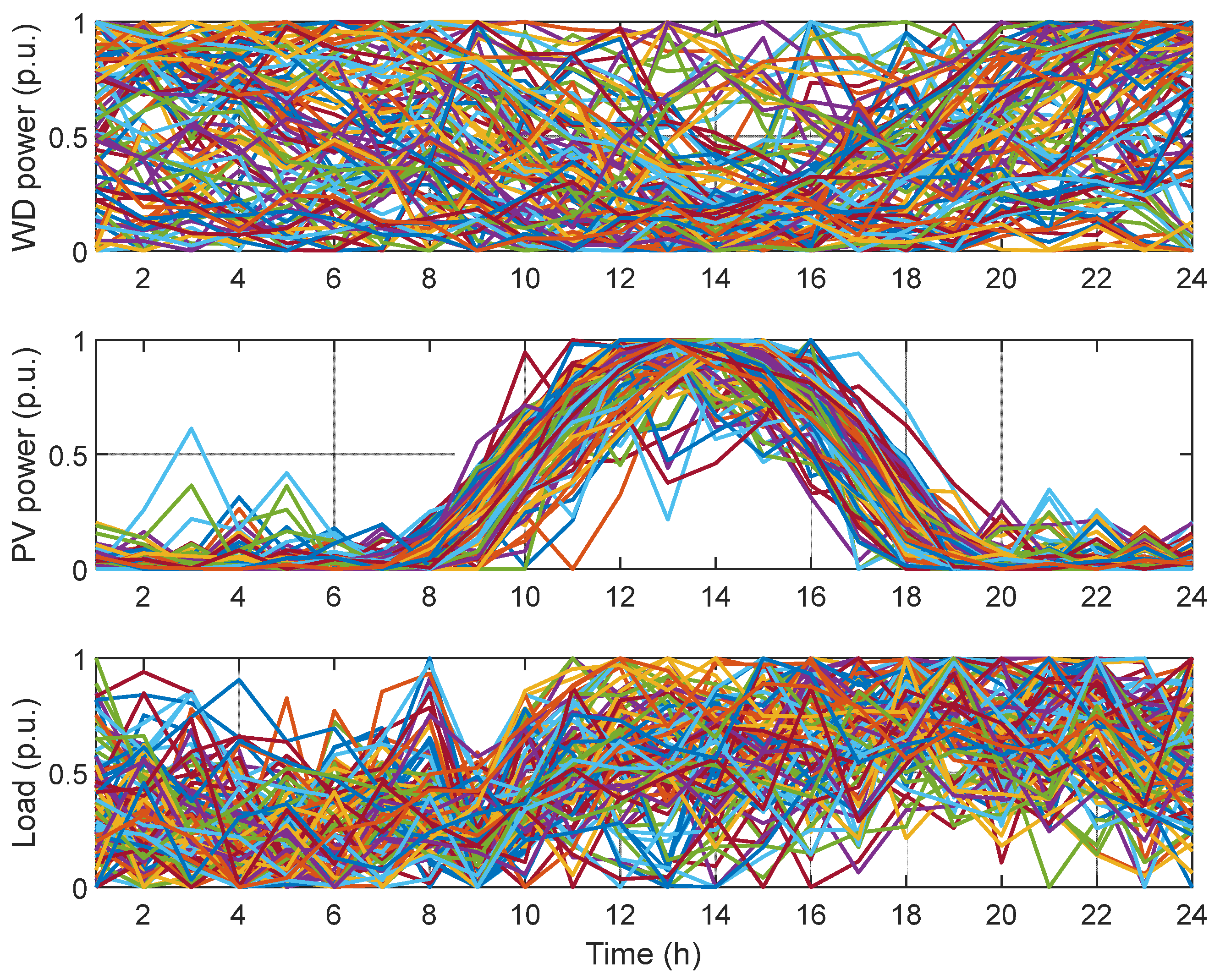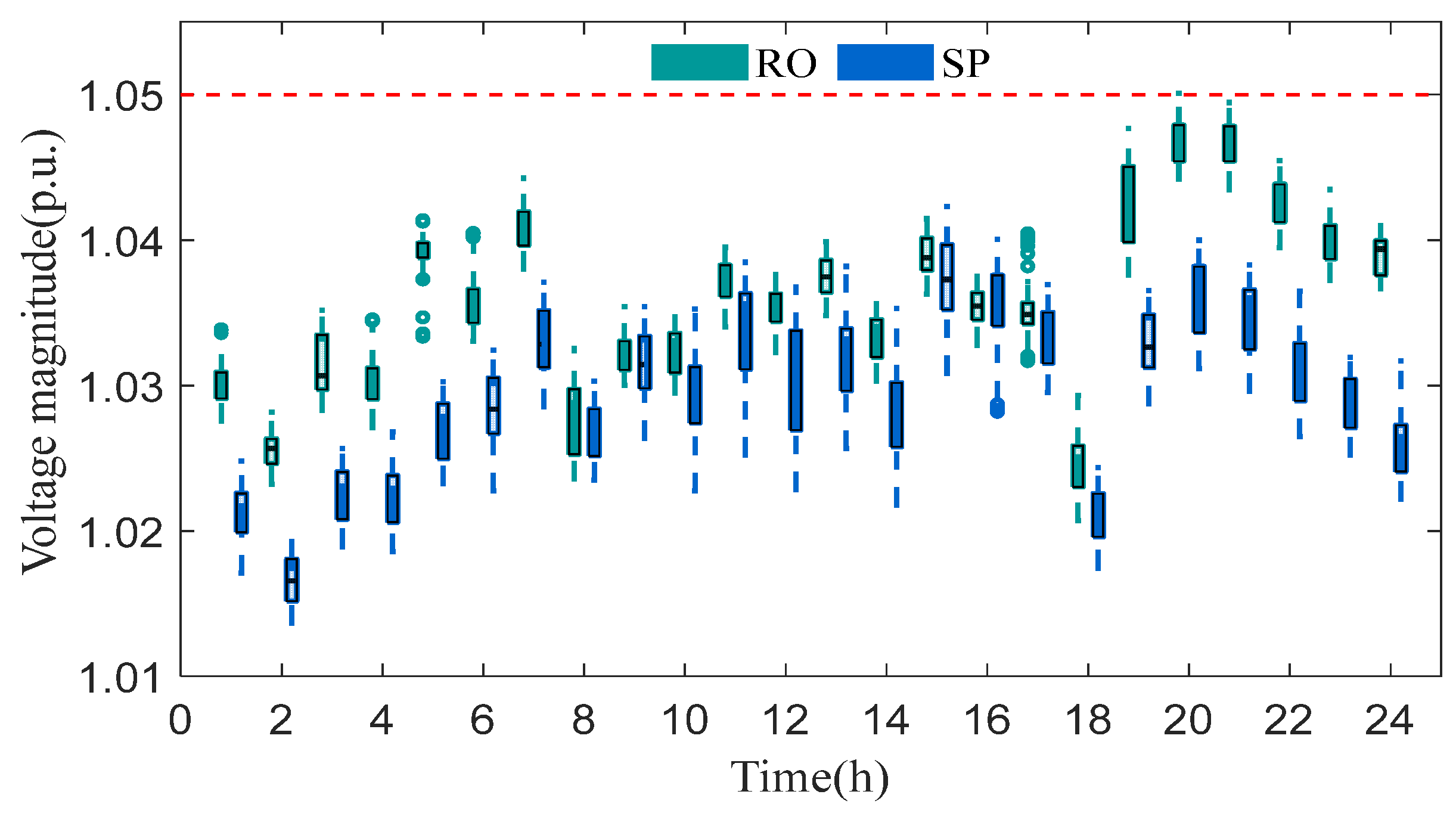Flexible Interconnection Planning Towards Mutual Energy Support in Low-Voltage Distribution Networks
Abstract
1. Introduction
- This paper presents a novel two-stage robust optimization framework for flexible interconnection planning in LVDAs, integrating investment and operational decisions under source–load uncertainty to enhance system resilience.
- A systematic quantitative evaluation is conducted, showing significant improvements in overload mitigation, voltage stability, and DER utilization. Even under worst-case scenarios, DER accommodation remains consistently high.
- The framework leverages the CCG algorithm combined with a distributed subproblem strategy, which effectively addresses dual-induced nonlinearity and ensures both computational tractability and efficiency.
2. Flexible Interconnection Robust Planning Model
2.1. Source–Load Uncertainty Model
2.1.1. Benchmark Prediction Power Model
2.1.2. Stochastic Disturbance Augmentation of Predictions
2.1.3. Box-Type Uncertainty Set Construction
2.2. Two-Stage Robust Optimization Model
2.2.1. Objective Function
2.2.2. Constraints
- (1)
- Power Balance in LVDAs:
- (2)
- VSC Power Constraint
- (3)
- Linearized Power Flow Constraints in DNs
- (4)
- Renewable Energy Utilization Constraint
- (5)
- Loading Constraint
- (6)
- Interconnection Line Transmission Capacity Constraint
- (7)
- Voltage Limits
- (8)
- Load Shedding Constraint
3. Bi-Level Robust Optimization Model
3.1. Construction of the Two-Stage Robust Optimization Model
3.2. Solution Methodology
| Algorithm 1: CCG and distributed algorithm for solving the proposed RO model |
|
4. Case Study
4.1. System Data
4.2. Performance Comparison
5. Conclusions
- In contrast to most existing studies that address only limited scenarios and local overload relief, the proposed robust planning delivers broader benefits, including reduced voltage fluctuations, elimination of severe overloads, stronger local self-sufficiency, and more reliable renewable integration. Although it incurs higher investment costs due to conservatism, these are offset by improvements in resilience and long-term reliability, making it well-suited for high-uncertainty environments.
- The evaluation is restricted to the IEEE 33-bus benchmark system, and broader validation on larger, real-world networks is still required; the robust formulation can be overly conservative compared with correlation-aware or probabilistic approaches.
- Future research should explore joint planning with other flexibility resources such as energy storage, soft open points, and demand response, as well as the adoption of distributionally robust or chance-constrained formulations to reduce conservatism while improving economic efficiency and scalability.
Author Contributions
Funding
Data Availability Statement
Conflicts of Interest
References
- Fathabad, M.; Cheng, J.; Pan, K.; Qiu, F. Data-Driven Planning for Renewable Distributed Generation Integration. IEEE Trans. Power Syst. 2020, 35, 4357–4368. [Google Scholar] [CrossRef]
- De Carne, G.; Buticchi, G.; Zou, Z.; Liserre, M. Reverse Power Flow Control in a ST-Fed Distribution Grid. IEEE Trans. Smart Grid 2018, 9, 3811–3819. [Google Scholar] [CrossRef]
- Rehmani, M.H.; Reisslein, M.; Rachedi, A.; Erol-Kantarci, M.; Radenkovic, M. Integrating Renewable Energy Resources Into the Smart Grid: Recent Developments in Information and Communication Technologies. IEEE Trans. Ind. Inform. 2018, 14, 2814–2825. [Google Scholar] [CrossRef]
- Ledva, G.S.; Balzano, L.; Mathieu, J.L. Real-Time Energy Disaggregation of a Distribution Feeder’s Demand Using Online Learning. IEEE Trans. Power Syst. 2018, 33, 4730–4740. [Google Scholar] [CrossRef]
- Li, P.; Jin, B.; Wang, D.; Zhang, B. Distribution System Voltage Control Under Uncertainties Using Tractable Chance Constraints. IEEE Trans. Power Syst. 2019, 34, 5208–5216. [Google Scholar] [CrossRef]
- Munikoti, S.; Abujubbeh, M.; Jhala, K.; Natarajan, B. An Information Theoretic Approach to Identify Dominant Voltage Influencers for Unbalanced Distribution Systems. IEEE Trans. Power Syst. 2022, 37, 4436–4446. [Google Scholar] [CrossRef]
- Haider, Z.M.; Mehmood, K.K.; Khan, S.U.; Khan, M.O.; Wadood, A.; Rhee, S.-B. Optimal Management of a Distribution Feeder During Contingency and Overload Conditions by Harnessing the Flexibility of Smart Loads. IEEE Access 2021, 9, 40124–40139. [Google Scholar] [CrossRef]
- Dharmapala, K.D.; Rajapakse, A.; Narendra, K.; Zhang, Y. Machine Learning Based Real-Time Monitoring of Long-Term Voltage Stability Using Voltage Stability Indices. IEEE Access 2020, 8, 222544–222555. [Google Scholar] [CrossRef]
- Rabiee, A.; Keane, A.; Soroudi, A. Enhanced Transmission and Distribution Network Coordination to Host More Electric Vehicles and PV. IEEE Syst. J. 2022, 16, 2705–2716. [Google Scholar] [CrossRef]
- Wang, J.; Zhou, N.; Chung, C.Y.; Wang, Q. Coordinated planning of converter-based dg units and soft open points incorporating active management in unbalanced distribution networks. IEEE Trans. Sustain. Energy 2020, 11, 2015–2027. [Google Scholar] [CrossRef]
- Hakala, T.; Lähdeaho, T.; Järventausta, P. Low-voltage dc distribution—Utilization potential in a large distribution network company. IEEE Trans. Power Deliv. 2015, 30, 1694–1701. [Google Scholar] [CrossRef]
- Gu, M.; Meegahapola, L.; Wong, K.L. Coordinated Voltage and Frequency Control in Hybrid AC/MT-HVDC Power Grids for Stability Improvement. IEEE Trans. Power Syst. 2021, 36, 635–647. [Google Scholar] [CrossRef]
- Behera, P.K.; Pattnaik, M. Hybrid Energy Storage Integrated Wind Energy Fed DC Microgrid Power Distribution Control and Performance Assessment. IEEE Trans. Sustain. Energy 2024, 15, 1502–1514. [Google Scholar] [CrossRef]
- Li, H.; Ren, Z.; Trivedi, A.; Verma, P.P.; Srinivasan, D.; Li, W. A noncooperative game-based approach for microgrid planning consider ing existing interconnected and clustered microgrids on an island. IEEE Trans. Sustain. Energy 2022, 13, 2064–2078. [Google Scholar] [CrossRef]
- Lotfi, H.; Khodaei, A. AC versus DC microgrid planning. IEEE Trans. Smart Grid 2017, 8, 296–304. [Google Scholar] [CrossRef]
- Liu, H.J.; Shi, W.; Zhu, H. Hybrid Voltage Control in Distribution Networks Under Limited Communication Rates. IEEE Trans. Smart Grid 2019, 10, 2416–2427. [Google Scholar] [CrossRef]
- Watson, J.D.; Lestas, I. Frequency and Voltage Regulation in Hybrid AC/DC Networks. IEEE Trans. Control Syst. Technol. 2021, 29, 1839–1849. [Google Scholar] [CrossRef]
- Peng, H.M.; Xiao, Q.H.; Tan, M.; Su, Y.X.; Li, H. Short-term maximum power supply capability assessment of low-voltage flexible interconnection distribution networks based on temporal convolutional neural network. South. Power Grid Technol. 2025, 1–11. [Google Scholar]
- Niazi, Y.; Golshan, M.E.H.; Alhelou, H.H. Combined Firm and Renewable Distributed Generation and Reactive Power Planning. IEEE Access 2021, 9, 133735–133745. [Google Scholar] [CrossRef]
- Sheng, H.; Wang, X. Applying Polynomial Chaos Expansion to Assess Probabilistic Available Delivery Capability for Distribution Networks with Renewables. IEEE Trans. Power Syst. 2018, 33, 6726–6735. [Google Scholar] [CrossRef]
- Cao, F.; Zheng, J.Z.; Zheng, Y.X. Flexible Interconnection Planning Method for Distribution Substations in High-Quality Photovoltaic Resource Areas Based on VSC. South. Power Grid Technol. 2023, 17, 14–25. [Google Scholar] [CrossRef]
- Cao, X.; Cao, T.; Gao, F.; Guan, X. Risk-Averse Storage Planning for Improving RES Hosting Capacity Under Uncertain Siting Choices. IEEE Trans. Sustain. Energy 2021, 12, 1984–1995. [Google Scholar] [CrossRef]
- Poudyal, A.; Poudel, S.; Dubey, A. Risk-Based Active Distribution System Planning for Resilience Against Extreme Weather Events. IEEE Trans. Sustain. Energy 2023, 14, 1178–1192. [Google Scholar] [CrossRef]
- Sheikhinejad, R.; Gharehpetian, G.B.; Rastegar, H. Active distribution network expansion planning considering microgrids for supplying critical loads. Sustain. Energy Grids Netw. 2024, 38, 101281. [Google Scholar] [CrossRef]
- Li, C.; Li, Y.; Xia, S.; Wang, P. A two-stage adaptive-robust optimization model for active distribution network with high penetration wind power generation. IET Renew. Power Gener. 2023, 18, 1204–1217. [Google Scholar] [CrossRef]
- Jing, H.; Zhao, C. A data expansion based piecewise regression strategy for incrementally monitoring the wind turbine with power curve. J. Cent. South Univ. 2023, 30, 1601–1617. [Google Scholar] [CrossRef]
- Vilanova, A.; Kim, B.-Y.; Kim, C.K.; Kim, H.-G. Linear-Gompertz Model-Based Regression of Photovoltaic Power Generation by Satellite Imagery-Based Solar Irradiance. Energies 2020, 13, 781. [Google Scholar] [CrossRef]
- Lee, G.-C. Regression-based methods for daily peak load forecasting in South Korea. Sustainability 2022, 14, 3984. [Google Scholar] [CrossRef]
- Xiao, J.; Zu, G.; Zhou, H.; Zhang, X. Total quadrant security region for active distribution network with high penetration of distributed generation. J. Mod. Power Syst. Clean Energy 2021, 9, 128–137. [Google Scholar] [CrossRef]
- Zhang, Z. An optimal scheduling of renewable energy in flexible interconnected distribution networks considering extreme scenarios. IET Renew. Power Gener. 2023, 17, 2531–2541. [Google Scholar] [CrossRef]
- Li, J.; Xu, Z.; Zhao, J.; Zhang, C. Distributed online voltage control in active distribution networks considering PV curtailment. IEEE Trans. Ind. Inform. 2019, 15, 5519–5530. [Google Scholar] [CrossRef]
- Sundarajoo, S.; Soomro, D.M. Optimal Load Shedding for Voltage Collapse Prevention Following Overloads in Distribution System. Int. J. Eng. 2023, 36, 1230–1238. [Google Scholar] [CrossRef]
- Carmona, R.; Yang, X. Glasso model for electric load and wind power and monte Carlo scenario generation. arXiv 2021, arXiv:2111.14628. [Google Scholar] [CrossRef]
- Available online: https://pan.baidu.com/s/1sTJSDBwQnZiHK8Yj0KdzbQ (accessed on 13 September 2025).









| Investment Cost ($) | Operational Costs ($) | Total Costs ($) | |
|---|---|---|---|
| RO | 419.26 | 306.45 | 725.71 |
| SP | 337.84 | 313.73 | 651.57 |
| 2% | 4% | 6% | 8% | 10% | ||
|---|---|---|---|---|---|---|
| AI | RO | 0.00046 | 0.00052 | 0.00073 | 0.0012 | 0.0019 |
| SP | 0.0059 | 0.0063 | 0.0060 | 0.0077 | 0.0075 | |
| VQ | RO | 0.0048 | 0.0051 | 0.0064 | 0.0074 | 0.0079 |
| SP | 0.0078 | 0.0072 | 0.0084 | 0.0087 | 0.0093 | |
| OS | RO | 0 | 0 | 0 | 0 | 0 |
| SP | 25.374 | 26.526 | 28.902 | 28.981 | 27.442 | |
| DER utilization | RO | 90.12% | 89.46% | 89.03% | 86.62% | 84.29% |
| SP | 90.69% | 89.77% | 89.34% | 88.13% | 88.26% | |
Disclaimer/Publisher’s Note: The statements, opinions and data contained in all publications are solely those of the individual author(s) and contributor(s) and not of MDPI and/or the editor(s). MDPI and/or the editor(s) disclaim responsibility for any injury to people or property resulting from any ideas, methods, instructions or products referred to in the content. |
© 2025 by the authors. Licensee MDPI, Basel, Switzerland. This article is an open access article distributed under the terms and conditions of the Creative Commons Attribution (CC BY) license (https://creativecommons.org/licenses/by/4.0/).
Share and Cite
Bai, H.; Tan, Y.; Rao, Q.; Li, W.; Liu, Y. Flexible Interconnection Planning Towards Mutual Energy Support in Low-Voltage Distribution Networks. Electronics 2025, 14, 3696. https://doi.org/10.3390/electronics14183696
Bai H, Tan Y, Rao Q, Li W, Liu Y. Flexible Interconnection Planning Towards Mutual Energy Support in Low-Voltage Distribution Networks. Electronics. 2025; 14(18):3696. https://doi.org/10.3390/electronics14183696
Chicago/Turabian StyleBai, Hao, Yingjie Tan, Qian Rao, Wei Li, and Yipeng Liu. 2025. "Flexible Interconnection Planning Towards Mutual Energy Support in Low-Voltage Distribution Networks" Electronics 14, no. 18: 3696. https://doi.org/10.3390/electronics14183696
APA StyleBai, H., Tan, Y., Rao, Q., Li, W., & Liu, Y. (2025). Flexible Interconnection Planning Towards Mutual Energy Support in Low-Voltage Distribution Networks. Electronics, 14(18), 3696. https://doi.org/10.3390/electronics14183696






